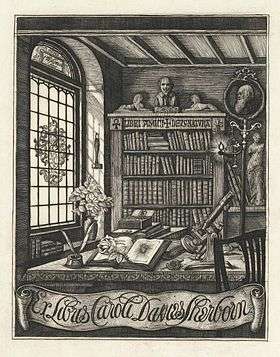Charles Davies Sherborn

Charles Davies Sherborn (30 June 1861 – 22 June 1942) was an English bibliographer, paleontologist and geologist.[1] He wrote Index Animalium, an 11-volume, 9,000-page work that catalogued the 444,000 names of every living and extinct animal discovered between 1758 and 1850. This work is considered the bibliographic foundation for zoological nomenclature. In addition, Sherborn authored almost 200 books, papers, and catalogs on a wide variety topics in natural history. He made important contributions to the study of microfossils and was a founding member and first president of the Society for the Bibliography of Natural History.[2] In recognition of his endeavours he was awarded an Honorary Doctorate from Oxford University.[3]
Early life
Sherborn was the eldest son of Charles William Sherborn, an engraver of some renown, and Hannah Sherborn (née Simpson). As a youth he was an enthusiastic collector of rocks, fossils, and freshwater shells. His formal education ended abruptly at age 14 when financial difficulties in his father's business forced him to quit school and earn a living. For the next several years he worked in the book trade at a bookshop on Bond Street. During his spare time he studied at the Museum of Practical Geology.[1]
Geology
Sherborn developed a passionate interest in geology and paleontology and in 1883 he was asked by geologist Thomas Rupert Jones to help illustrate and complete some papers he was writing on fossil Foraminifera. Jones was to become a close colleague and mentor for Sherborn. By 1887, they had published three papers, with Sherborn providing the illustrations. Challenged by the great number of journals they had to consult in preparing their papers, Sherborn began to compile his first bibliography, A Bibliography of the Foraminifera, published in 1888.[4] Around this time he was hired by the Geology department at the Natural History Museum to clean and prepare fossils. His pay was based on the number of fossils he prepared. In this new role he had the opportunity to collaborate with Arthur Smith Woodward, an expert on fossil fish and another influential colleague in Sherborn's career.[1]
Bibliography
Encouraged by the success of his first bibliography, Sherborn began to contemplate a much more ambitious project—the indexing of every living and extinct animal species discovered since 1758. The scope of what he was proposing may not have been apparent at first; initially he had planned to end the index at 1899. Even after scaling back to 1850, the task before him was immense. He began working on his Index Animalium in 1890. During the day he continued to prepare fossils in the museum while at night he would work at home, methodically going through thousands of books and journals, recording onto slips of paper every species name he came across. In just the first year he reviewed 500 scientific references and recorded about 40,000 names. By the time he was done he had reviewed thousands of books and journals in multiple languages and had created over a million handwritten records. Just sorting the records into alphabetic order took over three years. The first volume was published in 1902 and covered the time period 1758-1800. Covering the next 50 years required another 10 volumes (a measure of the explosive growth of scientific knowledge) and wasn't completed until 1932.[1]
In 1892 Sherborn was invited to assist on a biography of Richard Owen, founder of the Natural History Museum and one of the most famous scientists of his era.[5] He was required to sort through Owen's papers, which had been left, in piles twelve feet high, in a cowshed exposed to rats and to the elements. Despite Sherborn's great pleasure in the task, the effort involved caused a breakdown in his health that left him nearly incapacitated for three years.[3] Nevertheless, Sherborn succeeded with the enormous task, sorting and distributing hundreds of scientific papers and thousands of pages of correspondence.
Sherborn enjoyed bringing his colleagues together for his famous "smoke and chat" parties at his home. These were usually all-male, informal affairs and guests included museum staff as well as personal friends.[1] He never married; although engaged for ten years, he concluded that his sporadic income would be insufficient to provide for a wife and family.[3]
Notes
References
- Evenhuis, Neal (2016). "Charles Davies Sherborn and the "Indexer's Club"". ZooKeys. 550: 13–32. doi:10.3897/zookeys.550.9697. PMC 4741212. PMID 26877650.
- Miller, Giles (2016). "Sherborn's foraminiferal studies and their influence on the collections at the Natural History Museum, London". ZooKeys. 550: 71–81. doi:10.3897/zookeys.550.9863. PMC 4741215. PMID 26877653.
- Shindler, Karolyn (7 December 2010). "Richard Owen: the greatest scientist you've never heard of". The Telegraph. Retrieved 3 February 2016.
- Shindler, Karolyn (19 July 2011). "Charles Davies Sherborn, the Natural History Museum's 'magpie with a card-index mind'". The Daily Telegraph. Retrieved 19 July 2011.
- Shindler, Karolyn (2016). "A magpie with a card-index mind – Charles Davies Sherborn 1861–1942". ZooKeys. 550: 33–56. doi:10.3897/zookeys.550.9975. PMC 4741213. PMID 26877651.
- Ellinor Michel (2016), Anchoring Biodiversity Information: From Sherborn to the 21st century and beyond; ZooKeys 550: 1–11 (2016 doi 10.3897; zookeys 550.7460